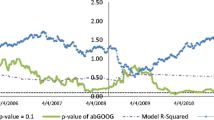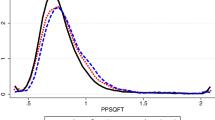Abstract
This paper analyzes the rental term structure taking into account the opportunity costs faced by the tenant for varying lease lengths. The analysis involves the application of a multi-period stock inventory model. The implication of the model is that the term structure of rents is determined by a clientele effect that can bias the occupancy value derived from using rational-expectations in the term structure relationship. The model does, however, reveal the characteristic stock-inventory U-shaped function that will determine the optimal lease length for a given tenant.
Similar content being viewed by others
References
Alonso, W. (1964). Location and Land Use: Toward a General Theory of Land Rent. Cambridge, MA: Harvard University Press.
Alvarez, L. H. R. (1999). “Optimal Exit and Valuation under Demand Uncertainty: A Real Options Approach,” European Journal of Operational Research 114(2), 320–329.
Ambrose, B., P. Hendershott, and M. Klosek. (2002). “Pricing Upward-Only Adjusting Leases,” Journal of Real Estate Finance and Economics 25, 33–49.
Baumol, W. J. (1952). “The Transactions Demand for Cash: An Inventory Theoretic Approach,” Quarterly Journal of Economics 66, 545–556.
Baumol, W. J. (1977). Economic Theory and Operations Analysis. Englewood-Cliffs, NJ: Prentice-Hall.
Baumol, W. J., J. C. Panzar, and R. D. Willig. (1982). Contestable Markets and the Theory of Industry Structure. New York: Harcourt Brace Jovanovich.
Buetow G. W., and J. D. Albert. (1998). “The Pricing of Embedded Option in Real Estate Lease Contracts,” Journal of Real Estate Research 15(3), 253–265.
Chiang, C. T. Lai, and D. C. Ling. (1986). “Retail Leasehold Interests: A Contingent Claim Analysis,” AREUEA Journal 14, 216–229.
Culbertson, J. M. (1957). “The Term Structure of Interest Rates,” Quarterly Journal of Economics November, 489–504.
Geltner, D. M., and N. G. Miller. (2001). Commercial Real Estate Analysis and Investments. New Jersey: Prentice-Hall.
Grenadier, S. (1995). “Valuing Lease Contract: A Real Options Approach,” Journal of Financial Economics 38, 297–331.
Goslings, J. H. W. (1981). “One-Period Optimal Cash Balances,” Paper presented at the conference of the European Finance Association Meeting, Sheveningen, The Netherlands.
Gunnelin, A., and B. Soderberg. (2001). “Term Structures in the Office Rental Markets in Stockholm,” Cambridge-Maastricht Symposium.
Hendershott, P. H., and C. W. R. Ward. (2000). “Incorporating Option-Like Features in Valuation of Shopping Center Leases,” Real Estate Finance 16(4), 31–36.
Hicks, J. M. (1946). Value and Capital. 2nd edition. London: Oxford University Press.
Kessel, R. A. (1965). The Cyclical Behavior of Interest Rates. New York: National Bureau of Economic Research.
Lizieri C. M., and G. Herd. (1994). “Valuing and Appraising New Lease Forms; The Case of Break Clauses in Office Markets,” Proceedings of the RICS “The Cutting Edge” Conference, U.K., pp. 127–144.
Love, S. (1979). Inventory Control. New York: McGraw-Hill Inc.
McAllister, P. (2001). “Pricing Short Leases and Break Clauses using Simulation Methodology,” Journal of Property Investment and Finance 19(4), 361–374.
McCann, P. (1998). The Economics of Industrial Location: A Logistics-Costs Approach. Heidelberg: Springer-Verlag.
McCann, P. (2001). “The optimal length of an industrial tenancy,” Journal of Property Research 18(4), 321–340.
Malkiel, B. G. (1962). “Expectations, Bond Prices, and the Term Structure of Interest Rates,” Quarterly Journal of Economics May, 197–218.
Meiselman, D. (1966). The Term Structure of Interest Rates. Princeton, NJ: Princeton University Press.
Nelson, C. (1972). The Term Structure of Interest Rates. NY: Basic Books.
Ostbye, S. (1997). “A Real Options Approach to Investment in Factor Demand Models,” Applied Economics Letters 4(3), 153–157.
Simpson, W. (1992). Urban Structure and the Labour Market: Worker Mobility, Commuting and Underemployment in Cities. Oxford: Clarendon Press.
Sprenkle, C. M., and M. H. Miller. (1980). “The Precautionary Demand for Narrow and Broad Money,” Economica 47, 407–421.
Tobin, J. (1956). “The Interest Elasticity of the Transactions Demand for Cash,” Review of Economics and Statistics 38, 241–248.
Vernon, R. (1964). “International Investment and International Trade in the Product Cycle,” Quarterly Journal of Economics 80(2), 190–207.
Wheaton, W. C., and D. DiPasquale. (1996). Urban Economics and Real Estate Markets. Englewood-Cliffs, NJ: Prentice-Hall.
Author information
Authors and Affiliations
Rights and permissions
About this article
Cite this article
McCann, P., Ward, C. Real Estate Rental Payments: Application of Stock-Inventory Modeling. The Journal of Real Estate Finance and Economics 28, 273–292 (2004). https://doi.org/10.1023/B:REAL.0000011157.78122.6c
Issue Date:
DOI: https://doi.org/10.1023/B:REAL.0000011157.78122.6c




